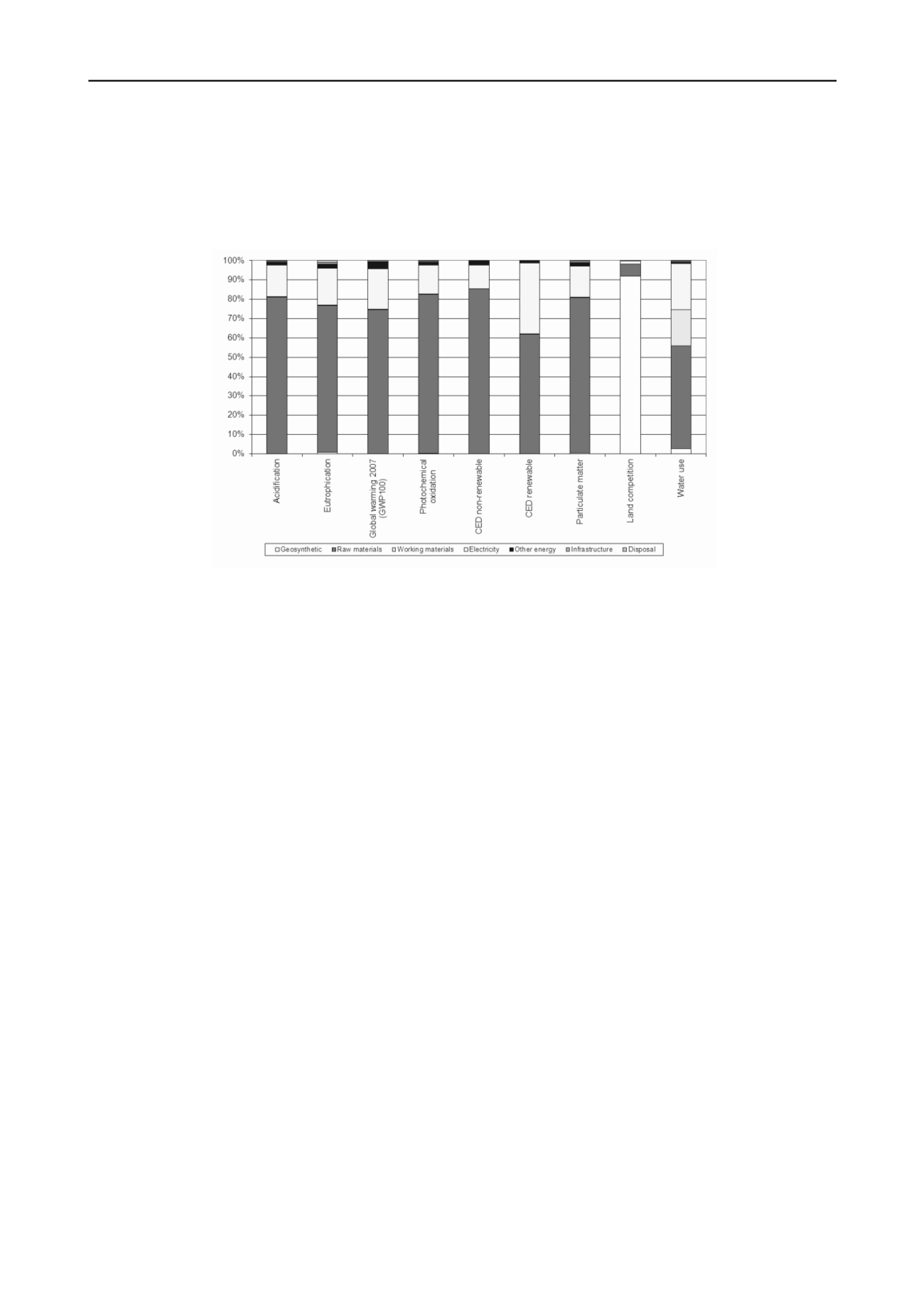
3206
Proceedings of the 18
th
International Conference on Soil Mechanics and Geotechnical Engineering, Paris 2013
overall impacts). The impacts are dominated by the direct
land use, i.e. land which is occupied by the manufacturer
plant in which the geosynthetic is produced. Indirect land use,
i.e. land occupation stemming from upstream processes, is
significantly lower because no land occupation is reported in
the inventories of plastic feedstock and no land intensive
products such as wood are used in considerable amounts.
Water consumption (tap water, deionised water, decarbonised
water) is included in the working materials. As a
consequence, this category bears about 15°% of the total
amount of water used.
Figure 3. Environmental impacts of the life cycle of 1 kg geosynthetic layer. Geosynthetic includes direct burdens of the geosynthetic production. Raw
materials include plastic, extrusion if necessary, and additives, working materials include water (tap and deionised) and lubricating oil, other energy
includes thermal energy and fuels, infrastructure covers the construction of the production plant and disposal comprises wastewater treatment and
disposal of different types of waste.
5 DISCUSSION AND CONCLUSION
A filter using a geosynthetic layer causes lower environmental
impacts compared to a conventional gravel based filter layer
with regard to all impact category indicators investigated. If
30 cm of gravel are saved, the specific climate change impact of
the construction of 1 square meter filter using geosynthetics is
about 7 kg CO
2
-eq lower compared to the impacts from the
construction of an equivalent gravel based filter.
The difference is considerable for all indicators (more than
85 %) and reliable. The difference in the environ¬men¬tal
impacts arises mainly because the applied geosynthetic
substitutes gravel, which causes considerably higher impacts
when extracted and transported to the place of use. At least a
layer of 8 cm of gravel must be replaced by geosynthetics used
as a filter in order to cause the same or lower environmental
impacts regarding all indicators.
The environmental impacts of the gravel based filter are
significantly reduced, when constructing smaller filters (20 cm
instead of 30 cm). Nevertheless, the sequence of the two cases
does not change and the difference is still significant between
the sensitivity cases of the mineral filter and the geosynthetic
filter.
6 REFERENCES
ecoinvent Centre (2010) ecoinvent data v2.2, ecoinvent reports No. 1-
25. Swiss Centre for Life Cycle Inventories, Duebendorf,
Switzerland, retrieved from:
.
Frischknecht R., Jungbluth N., Althaus H.-J., Bauer C., Doka G., Dones
R., Hellweg S., Hischier R., Humbert S., Margni M. and Nemecek
T. (2007) Implementation of Life Cycle Impact Assessment
Methods. ecoinvent report No. 3, v2.0. Swiss Centre for Life Cycle
Inventories, Dübendorf, CH, retrieved from:
.
Goedkoop M., Heijungs R., Huijbregts M. A. J., De Schryver A., Struijs
J. and van Zelm R. (2009) ReCiPe 2008 - A life cycle impact
assessment method which comprises harmonised category
indicators at the midpoint and the endpoint level. First edition.
Report I: Characterisation, NL, retrieved from: lcia-recipe.net/.
Guinée J. B., (final editor), Gorrée M., Heijungs R., Huppes G., Kleijn
R., de Koning A., van Oers L., Wegener Sleeswijk A., Suh S., Udo
de Haes H. A., de Bruijn H., van Duin R., Huijbregts M. A. J.,
Lindeijer E., Roorda A. A. H. and Weidema B. P. (2001a) Life
cycle assessment; An operational guide to the ISO standards; Part
3: Scientific Background. Ministry of Housing, Spatial Planning
and Environment (VROM) and Centre of Environmental Science
(CML), Den Haag and Leiden, The Netherlands, retrieved from:
Guinée J. B., (final editor), Gorrée M., Heijungs R., Huppes G., Kleijn
R., de Koning A., van Oers L., Wegener Sleeswijk A., Suh S., Udo
de Haes H. A., de Bruijn H., van Duin R., Huijbregts M. A. J.,
Lindeijer E., Roorda A. A. H. and Weidema B. P. (2001b) Life
cycle assessment; An operational guide to the ISO standards; Parts
1 and 2. Ministry of Housing, Spatial Planning and Environment
(VROM) and Centre of Environmental Science (CML), Den Haag
and
Leiden,
The
Netherlands,
retrieved
from:
PRé Consultants (2012) SimaPro 7.3.3, Amersfoort, NL, retrieved from:
.
Solomon S., Qin D., Manning M., Alley R. B., Berntsen T., Bindoff N.
L., Chen Z., Chidthaisong A., Gregory J. M., Hegerl G. C.,
Heimann M., Hewitson B., Hoskins B. J., Joos F., Jouzel J., Kattsov
V., Lohmann U., Matsuno T., Molina M., Nicholls N., Overpeck J.,
Raga G., Ramaswamy V., Ren J., Rusticucci M., Somerville R.,
Stocker T. F., Whetton P., Wood R. A. and Wratt D. (2007)
Technical Summary. In: Climate Change 2007: The Physical
Science Basis. Contribution of Working Group I to the Fourth
Assessment Report of the Intergovernmental Panel on Climate
Change (IPCC), Cambridge University Press, Cambridge, United
Kingdom and New York, NY, USA.
Stucki M., Büsser S., Itten R., Frischknecht R. and Wallbaum H. (2011)
Comparative Life Cycle Assessment of Geosynthetics versus
Conventional Construction Material. ESU-services Ltd.
commissioned by European Association for Geosynthetic
Manufacturers (EAGM), Uster and Zürich, CH.


